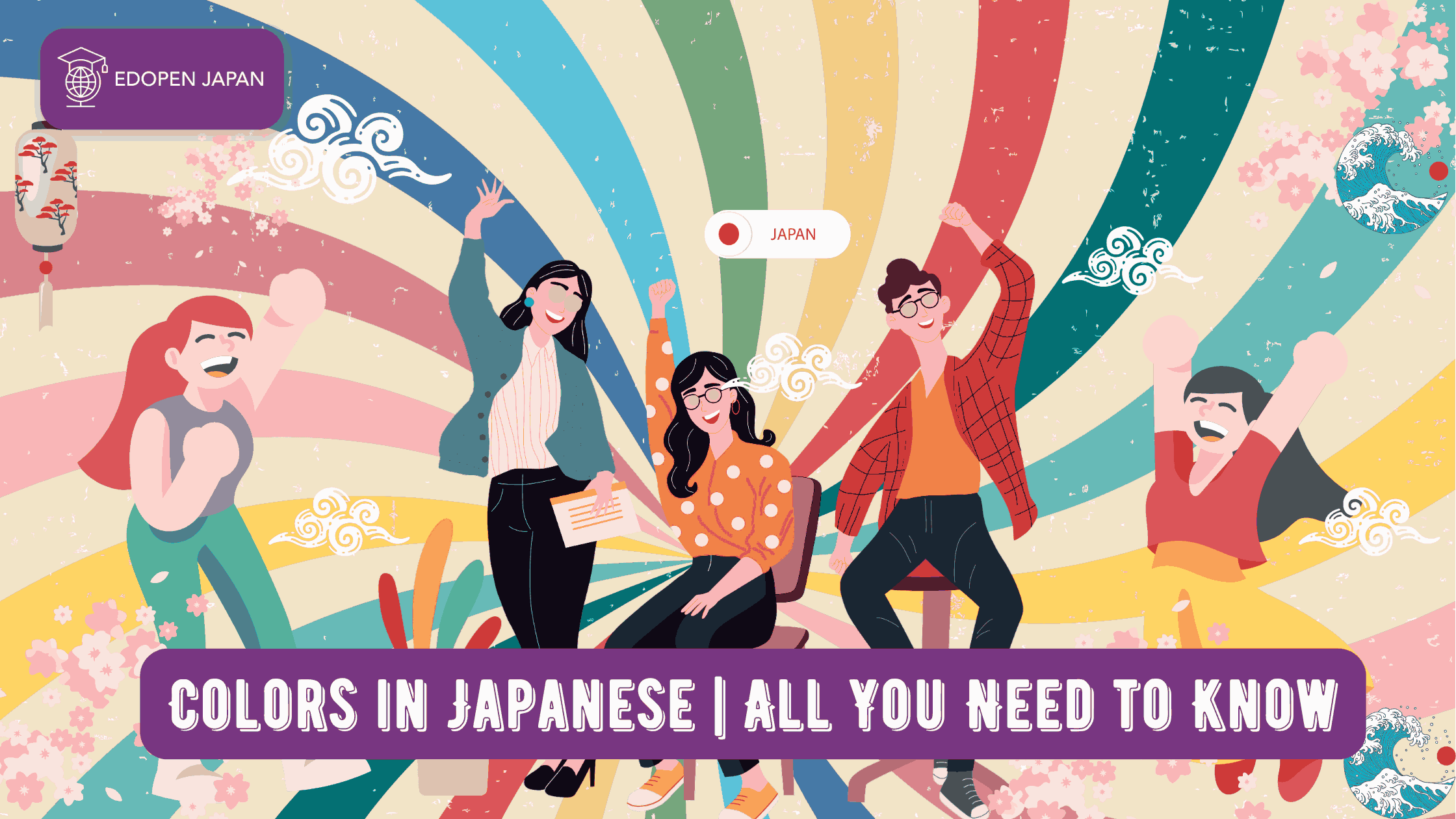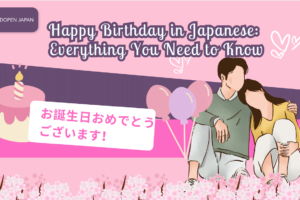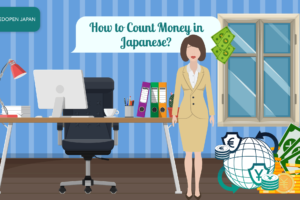Colors play an important role in communicating ideas, beliefs, and instructions. Likewise, in literature, color theory is significant as it conveys specific emotions and contributes to capturing a character’s personality.
In Japanese, there are numerous methods for explaining colors, which can be challenging to comprehend. This may cause difficulties for Japanese beginners in determining which context is appropriate to use in which version.
If you’re curious about properly describing the physical appearance of an object utilizing “Iro (色 / Colors)” or colors in the Japanese language, you can learn and master colors and their meanings in this article. Let’s begin learning below!
In addition, if you are currently studying other fundamental Japanese materials, we recommend reading the following suggestions to increase your knowledge and expertise in Japanese.
Read also:
How to Count Money in Japanese?
Japanese Weekdays – Everything You Need to Know
Jikoshoukai (自己紹介): How to Introduce Yourself in Japanese
Contents
The Basic Colors in Japanese

Unlike other languages, Japanese color words have two major forms: “Noun form” and “I-adjective” form. Unfortunately, these two forms only differ based on their function in the sentence, which makes it difficult for many language learners to comprehend the Japanese language.
However, understanding Japanese adjectives for basic colors is easy as you only need to add an additional “I” on the last letter for the noun form. Additionally, there are only six colors.
| English | Japanese | Romaji | Adjective Form | Romaji |
|---|---|---|---|---|
| Red | あか | Aka | あかい | Akai |
| Blue | あお | Ao | あおい | Aoi |
| Yellow | きいろ | Kiiro | きいろい | Kiiroi |
| Black | くろ | Kuroi | くろい | Kuroi |
| Brown | ちゃいろ | Chairo | ちゃいろい | Chairoi |
| White | しろ | Shiro | しろい | Shiroi |
Please remember to use “I-adjective forms” with the particle “no (の)” when using color words to modify nouns in the same way as in English. For example, you should say “green vase” as “midori no kabin (緑のかびん)” instead of “midori kabin.”
Nouns for Basic Colors in Japanese
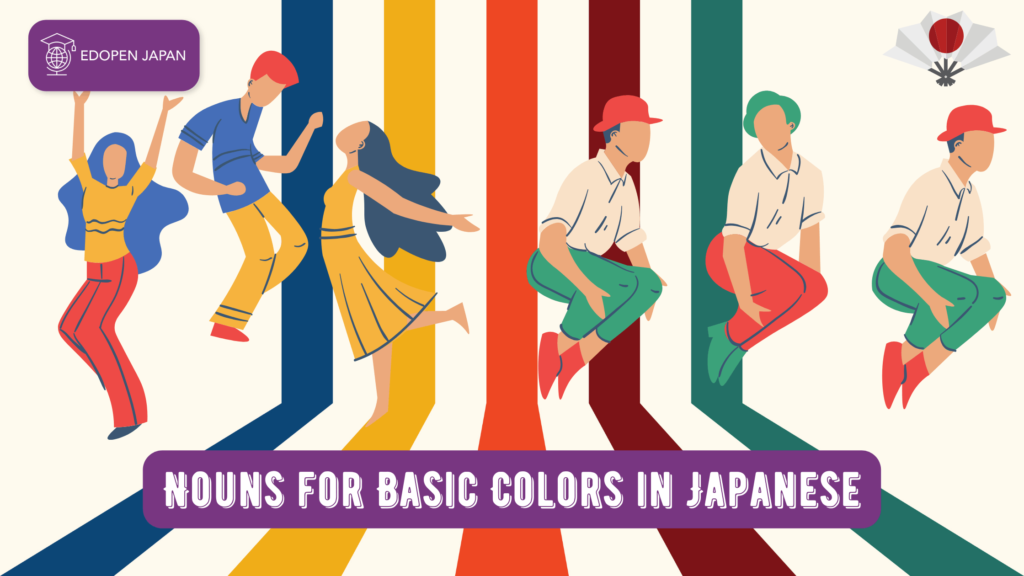
The following information guides you on how to change the color into a noun in Japanese.
| English | Japanese | Romaji |
|---|---|---|
| Red | あか | Aka |
| Yellow | きいろ | Kiiro |
| Green | みどり | Midori |
| Blue | あお | Ao |
| Purple | むらさき | Murasaki |
| Pink | ももいろ / ピンク | Momoiro/Pink |
| Brown | ちゃいろ | Chairo |
| Grey | はいいろ | Haiiro |
| Black | くろ | Kuro |
| White | しろ | Shiro |
These nouns denote various colors. Therefore, when describing the color of something, use the particle ‘no’ [の]. Please look at the other example below for further understanding!
Formula: Color + の + Subject
Example:
(1) Midori no madoguchi
みどりの窓口(まどぐち)
Green Window (usually referring to the ticket office at a train station in Japan)
(2) Murasaki no kutsushita
むらさきのくつした
Purple socks
The History of Japanese Colors

Color can be described using adjectives. Interestingly, only four colors become adjectives when “-i” is added directly to the end.
| Color | Kanji | Kana | Romaji |
|---|---|---|---|
| Red | 赤い | あかい | Akai |
| Blue | 青い | あおい | Aoi |
| Black | 黒い | くろい | Kuroi |
| White | 白い | しろい | Shiroi |
It is believed that the ancient Japanese had a basic color system consisting of four colors only: “Red (赤)”, “Blue (青), “Black (黒), and “White (白)”. One of the reasons behind this is that there are only four color names which can be used both as a single-color noun and as an adjective. An adjective, expressed in the “~ i” form, denotes the quality and condition of things. Look at the example below!
Example:
(1) 大きい (Ookii) = big,
(2) 小さい (Chiisai) = small
(3) きれい (Kirei) = beautiful
The Basic Color in Japanese
These four colors, the “Red,” “Blue,” “Black,” and “White,” are referred to as “赤い (Akai)”, “青い (Aoi)”, “黒い (Kuroi)” and “白い (Shiroi)” respectively. Other colors do not end in “~ i”. The studies indicate that before the use of letters, people did not possess words to describe colors, and they relied on “Brightness” and “Darkness” to distinguish between them.
In addition, there are four distinct qualities: “Bright”, “Dark”, “Clear”, and “Pale and Vague”.
(1) Bright (明るい – Akarui) is derived from red
(2) Dark (暗い – Kurai) from black
(3) Clear (白し – Shiroshi) from white
(4) Pale (あわい – Awai) from blue
Example:
(1) 青い海 (aoi umi) = the blue sea
(2) 海は青いです。(umi ha aoi desu) = the sea is blue
The Colors that become Adjective in Japanese
There are two additional colors that can function as adjectives, they are “黄色 (Kiiro – yellow)” and “茶色(Chairo – brown)” in Japanese. These colors were not included in the previous four because they cannot stand alone when used as colors.
Consequently, when used as adjectives, they are referred to as “黄色い (Kiiroi)” and “茶色い (Chairoi)”. Instead, they must be accompanied by the word “色 – iro (colors)” to become nouns for yellow and brown. Consequently, when used as adjectives, they are referred to as “黄色い (Kiiroi – yellow)” and “茶色い (Chairoi – brown) in Japanese.
The Blue and Green in Japanese
In the past, the Japanese considered blue and green to be one color, known as “Aoi (青い)”. Because the two were not separately distinguished until recently, the word “Aoi” is still used to refer to green objects, such as green apples (青りんご – Ao ringgo) or green traffic lights (青信号 – Ao singgo).
The Other Japanese Colors
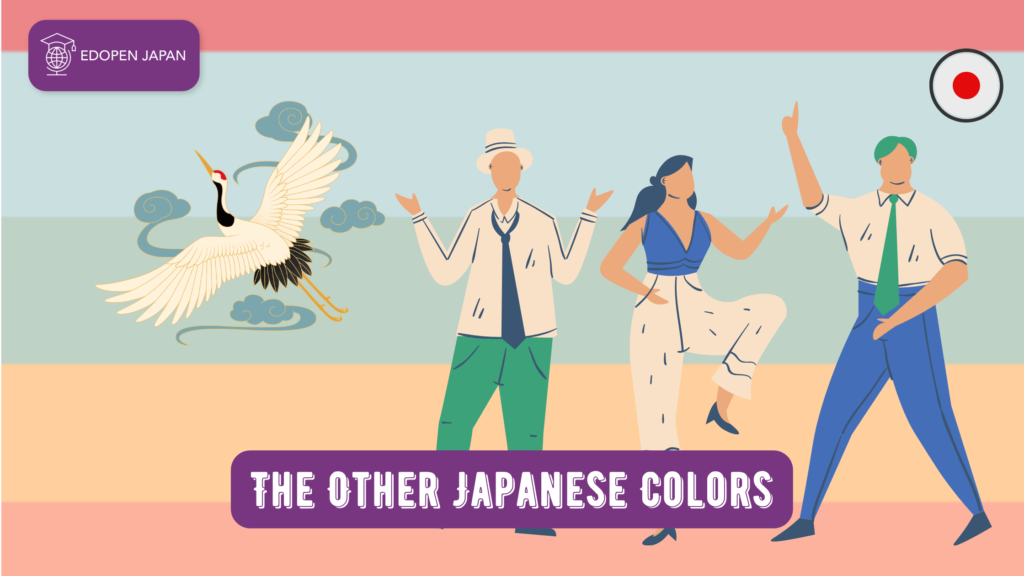
Now that we have covered the fundamentals of different color forms, let us shift our focus to other colors that you may wish to acquire.
Noteworthy, we will also include the katakana for English loan words used to describe colors. This is because a large set of young generations presently use the loanword version when communicating.
| English | Japanese | Romaji |
|---|---|---|
| Green | みどり | Midori |
| Purple | むらさき | Murasaki |
| Grey | はいいろ | Haiiro |
| Orange | だいだいいろ / オレンジ | Daidai-iro / Orenji |
| Pink | ももいろ / ピンク | Momo-iro / Pinku |
| Silver | ぎん / シルバー | Gin / Siruba- |
| Gold | きん / ゴールド | Kin / Gorudo |
| Rainbow | にじいろ | Nij-iro |
| Navy | こんいろ / ネイビー | Kon-iro / Neibi- |
| Light Blue | みずいろ | Mizuiro |
| Yellowish Green | きみどり | Kimidori |
| Beige | ベージュ | Beijyu |
The Meaning of Colors in Japanese
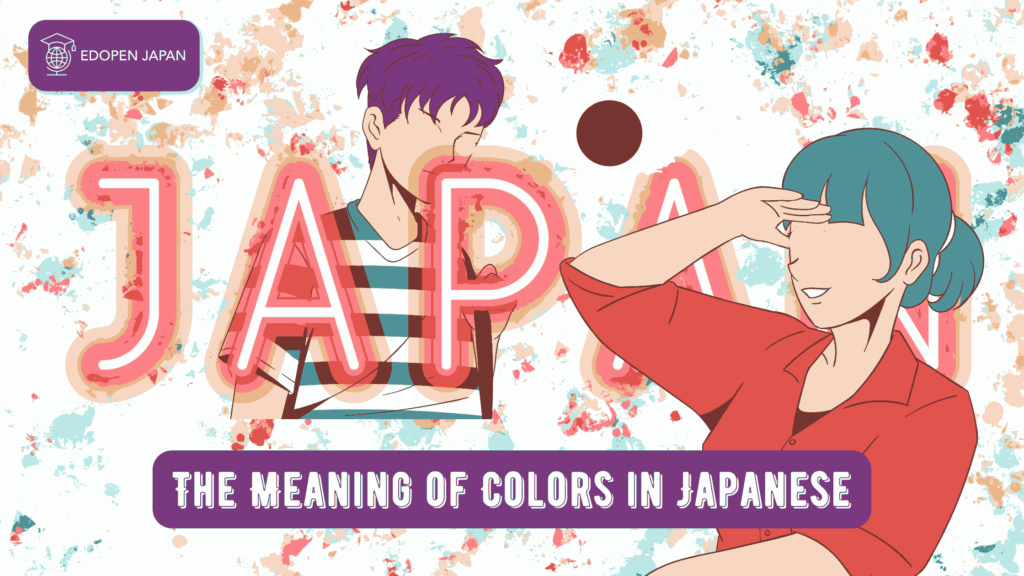
赤 (Aka – Red)
Red is often associated with authority, strength, sacrifice, joy, and happiness in Japanese culture. The Japanese flag, consisting of red and white, serves as evidence of this powerful hue. The central red circle in the flag symbolizes the sun. In Japan, this auspicious color is often paired with white, which is also present on the national flag.
In addition, red is also a color commonly used for decorations at significant events, including weddings and birthdays, and it is also often worn at such gatherings. In Japanese architecture, red is extensively utilized, particularly at Shinto shrines, where the specific red color, aka, is believed to provide protection against evil or disaster.
白 (Shiro – White)
In Japanese culture, white is a color that represents purity and cleanliness, and is considered sacred and blessed. White is widely appreciated in Japan because it symbolizes purity, and serves as the background color of Japan’s flag, representing the nation’s reverence for the gods in the light of the rising sun. White is particularly meaningful when paired with red.
White symbolizes divinity, truth, simplicity, humility, and mourning. Historically, it was primarily worn at funerals and seldom in everyday life.
However, Western influence has caused the color of mourning to change from white to black over time. Today, white is commonly worn in everyday settings, while black is still reserved for solemn occasions such as funerals.
黒 (Kuro – Black)
Black is often linked with formality, elegance, and mourning, as well as negative emotions such as unhappiness, fear, evil, bad luck, or misfortune. Throughout many cultures, black has been tied to death and destruction. As such, it is typically the color of mourning in many countries, including Japan.
From ancient times to the present day, black has served as the go-to color for makeup.In the past, the Japanese had a tradition of painting their teeth black. This unique tradition, known as o-haguro, involves staining one’s teeth black using a mixture of iron and vinegar, and is believed to prevent tooth decay. This practice is still observed in rural areas during funerals, as well as by some geishas on special occasions.
青 (Ao – Blue)
In Japan, the color blue represents purity, cleanliness, passivity, and fidelity due to the nation’s surroundings of blue water. Blue is regarded as a lucky color and commonly used in Japanese clothing like kimonos.
The term ‘Japan Blue’ originated from indigo dye during the Meiji period, and it is applied widely to clothing, textiles, everyday wear, and formal attire.
紫 (Murasaki – Purple)
Purple signifies royalty and can also connote nobility, spirituality, wisdom, and luxury. Historically, only affluent individuals in Japan could afford to wear purple garments, and the masses were prohibited from doing so.
緑 (Midori – Green)
Green, a color believed to bring good luck in Japan, signifies fertility, growth, youthfulness, permanence, vitality, and energy. The Japanese are known to have a strong appreciation for nature and commemorate Greenery Day on April 29 each year in honor of Emperor Shōwa’s birthday, who was renowned for his love for nature.
オレンジ (Orenji – Orange)
In Japanese culture, orange symbolizes happiness, love, and the sun, as well as knowledge and civilization. It is a highly favored color for clothing.
ピンク (Pinku – Pink)
Pink has connotations of femininity, spring, youth, and good health, and is a popular color in Japanese clothing. Additionally, it is associated with child-like personalities.
9. 黄色 (Kiiro – Yellow)
In Japan, yellow symbolizes nature and sunshine and is considered a sacred color in the Far East. There are many Japanese terms that incorporate yellow. For example, having a “yellow beak” indicates inexperience, while a “yellow voice” refers to the high-pitched voices of children and women.
茶色 (Chairo – Brown)
This brown hue embodies traits such as resilience, durability, ease, and an affinity for the natural world.
金 (King – Gold)
Gold is associated with wealth, royalty, prestige, and the color of the heavens in Japanese culture. It is commonly used to adorn temples and the statues of Lord Buddha.
銀 (Gin – Silver)
Silver is commonly associated with traits such as security, reliability, intelligence, staidness, modesty, and maturity, and often utilized in Japanese tools and weapons.
These colors represent fundamental values and ideals within Japanese society. They are frequently used in both traditional and celebratory clothing, such as kimonos, a type of traditional Japanese garment.
How was it? Mastering the colors in Japanese can be a little complicated, but once you understand the tips and meanings, it becomes easier. Now that you have learned various hues and their application, remember that life is colorful. So enjoy learning Japanese!
Summary
To summarize, let’s go over the information presented using these key points. Feel free to leave a comment in the section below.
- Color words in Japanese have two major forms: the “noun form” and the “i-adjective form”. For basic colors, add an additional “i” to the end of the noun form. Also, the basic formula for describing colors in Japanese is “Noun form” + の + Subject.
- It is said that the basic form of color in ancient Japanese was only four colors “Red (赤), “Blue (青)”, “Black (黒)”, and “White (白)”. Each color represents essential values, special meanings, and ideals of Japanese society.
- Japanese colors may seem complex, but with some helpful tips and meanings, mastering them becomes easier.

